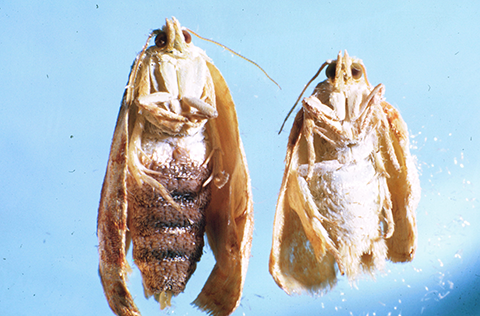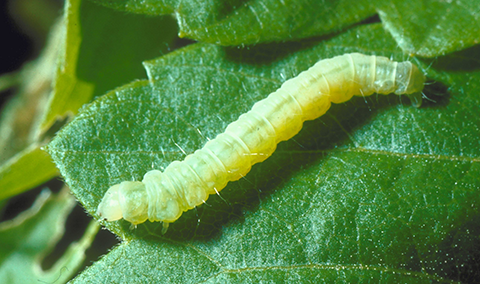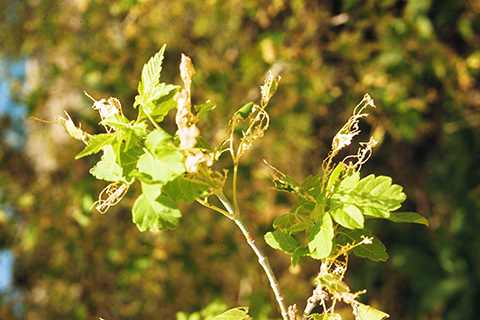Integrated Pest Management
Boxelder Leafroller
 Female (left) and male (right) boxelder leafroller moths. (U.S. Department of Agriculture Forest Service, Bugwood.org)
Female (left) and male (right) boxelder leafroller moths. (U.S. Department of Agriculture Forest Service, Bugwood.org)
 Boxelder leafroller larva. (Bill Klein, USDA Forest Service, Bugwood.org)
Boxelder leafroller larva. (Bill Klein, USDA Forest Service, Bugwood.org)
 Boxelder leafroller damage.(U.S. Department of Agriculture Forest Service, Bugwood.org)
Boxelder leafroller damage.(U.S. Department of Agriculture Forest Service, Bugwood.org)
HOSTS
- Boxelder
- Raspberry
- Birch
- Elderberry
- White elm
- Shrubs
DESCRIPTION
The boxelder leafroller, Archipsnegundanaa, is a pest of boxelder and other trees and shrubs in parts of the United States and Canada and is commonly found in Utah.
Adult females are buff-colored moths with a wing span of approximately 1 inch. The undersides of their abdomens are dark colored. Males are similar in appearance but are slightly smaller and light yellow on the underside of the abdomen. The larva is a greenish-yellow caterpillar that is 4/5 inch long when mature.
BIOLOGY
In northern Utah, moths may be present from late June through July. During this time, females mate and lay eggs in flattened masses of about 30 eggs, in branch forks and bark crevices. After overwintering, eggs hatch soon after budbreak and the young larvae crawl to developing leaves and feed in small groups. As larvae mature, they disperse and feed individually in leaves they have rolled with webbing. Larvae typically complete development by mid-June and pupate (form cocoons) within the rolled leaves or in bark crevices. Pupation takes approximately 2 weeks.
SYMPTOMS
- Webs along leaf folds and veins from young larvae
- Heavy infestations can result in complete defoliation of the tree by early to midsummer
GENERAL MANAGEMENT
As a general rule of thumb, if a deciduous tree is well established, growing under good conditions, in a suitable site, and is not under additional stress, it can usually withstand about 30%-35% leaf loss before its capability to store food reserves is reduced. In fact, established boxelder trees that have been completely defoliated for 3 consecutive years have continued to live and grow normally. Their capacity to re-leaf compensates somewhat for the early season leaf loss.
INSECTICIDES
Organic insecticides labeled for leafroller control on boxelder, maple, or ornamental shade trees include products containing Bacillus thuringiensis (strainsaizawaii and kurstaki) and spinosad. The caterpillar must consume these products, which are only effective on caterpillars a half-inch or less. There are many residential and commercial brands that contain either of these ingredients.
Conventional options include carbaryl, malathion, and pyrethroids, and work on all caterpillar sizes.

